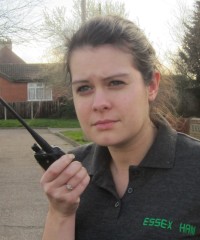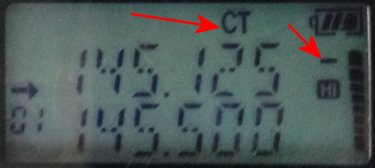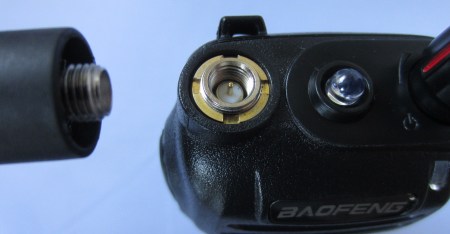Once you’ve got your licence, the first purchase you’re likely to make may well be a handheld radio. All the rage at the time of writing are the Baofeng radios such as the Baofeng UV-5R and Baofeng UV-B6, as these can be cheaply obtained from Amazon and eBay.
| Want a one-page printable guide? See our Getting Started Guides |
On this page, we outline a few things that you may need to consider.
Know the radio’s limitations
First off, so you’re not disappointed, it’s important to understand the limitations of these radios:
 Build quality – At £25, don’t expect a high-quality radio. They are made to be sold at budget prices, and are not the best quality.
Build quality – At £25, don’t expect a high-quality radio. They are made to be sold at budget prices, and are not the best quality.
Audio – Notable is the lowish quality of the microphone which can sound very muffled. Solutions include drilling out a bigger hole on the front of the radio to allow more sound to hit the mic – also worth considering is an external microphone, plugged into the socket at the side. If neither are an option for you, make sure you speak loudly and clearly at a suitable distance from the mic hole. Some experimentation may be needed.
Antenna – As you’ll hopefully remember from your Foundation course, we teach that VHF and UHF normally work “just beyond line of sight” and there’s a limited range. The free antenna supplied with a Baofeng-type radio is acceptable, but don’t expect much in the way of distance. At a high point out in the open with nothing in the way, hitting a repeater 10 or 20 miles away may well be possible. However, in a built-up area, in a dip, or where there is no clear line-of-sight, you may get nothing. See “improving your range” below.
Power – Although rated at 5 watts, that’s not necessarily what’s put out.
Other factors
Squelch – Check that this isn’t set too high. If it’s set too high, you’ll be blocking some signals. One of our members, Charlie M0PZT, suggests a squelch setting of “2” for the Baofeng UV-5R model, and again some experimentation may be needed.
Lack of activity – 2m can be a quiet band. Here in Essex, where there are lots of amateurs and clubs, it’s possible to monitor 2m and only hear a couple of people all day. Listening when a busy net is on (such as our Monday Night Net), is worth a try. If a net is on a repeater, listen to the Input frequency, as you may be able to hear local signals even if you can’t hear the repeater itself.
| In Essex? Listen on a Monday Night at 8pm. Repeater output frequency (Danbury) is 145.725MHz. The Input frequency is 145.125MHz. You can also listen online to check if the net is running and hear what others are saying. Details: Essex Ham Monday Night Net |
Difference in power – Don’t be disappointed if you hear someone calling, but they can’t hear you. It could be that they’re transmitting under ideal conditions at 50 watts. It’s easy to see how you, with an inferior antenna at 5 watts or less, may struggle to be heard clearly (if at all) in these circumstances
Repeater settings – If trying to work a repeater, you will need exactly the right settings to be programmed into your radio – The CTCSS tone on transmit, and the offset. Without both of these 100%, you won’t open the repeater. Setting up from a computer (with free software and a suitable programming lead) often is easier than trying to program using the on-screen menu and the radio’s button interface. Poorly-worded Chinese manuals don’t help either. See links at the bottom of the page for instructions on setting up some of the common Baofengs
Radio settings – Just check the obvious – Is the volume turned up? Is the antenna connected correctly? Are you on the right frequency? Is your radio set to some odd unexpected mode? As a last resort, try a factory reset.

Improving your Range
As explained above, using the basic rubber duck may not get you far. If you’re in a dip, a built-up area, or there’s a structure between you and the station/repeater you want to work, you’ll struggle.

The cheap antenna supplied with budget radios can be unscrewed normally revealing an SMA plug or socket – Connecting a better antenna will make a big difference. Here are some options:
Antenna height – As you’ll hopefully recall from Foundation, height is more important than power for VHF/UHF. If at home, ideally, a rooftop antenna is best – as high as you can get it. If that’s not immediately possible, an antenna in the loft could be a decent compromise – perhaps hanging from a bit of string nailed to the highest point of the loft. The roof tiles will attenuate the signal a little, but you’ll have the height.
Antenna type – Again, from Foundation, you’ll know this makes a difference. A decent Yagi (beam) antenna with a good gain, correctly polarised, and pointing at the target will give the best results, but this is often not practical. For most, a decent compromise is a 2m/70cm colinear white stick antenna (such as the Diamond X30 – approx £40, or a cheaper clone), on the roof or in the loft. Next option would be a home-made Slim Jim antenna (loft, or out the window). Last resort, a bigger / better rubber duck type antenna
Position – If you’re working using just the rubber duck antenna – Try going elsewhere – High up, closer to a repeater, less built-up area – again, perhaps when you know a busy net is on.
Go mobile – If you can’t get a good signal at home and a fixed aerial on the roof isn’t an option, get in the car. Get yourself a cheapish co-linear antenna and a mag mount. These have a magnetic base for the roof of your car, and the co-ax goes through the door seal. Cheap mag mounts use very thin co-ax cable, which is not great at UHF (see the next point), so don’t skimp too much. The metal roof of your car will act as a groundplane, and you have freedom to drive to a high point or find a nearby sweet-spot. Take a flask too!
Co-ax cable – If using an external antenna with co-ax cable, using RG213 (the thicker co-ax) may be better than the thinner RG58, especially if there’s a long run involved. It’s more expensive, but less lossy at VHF/UHF frequencies, and if you’re struggling for signal, it can make the difference.
Hopefully, this short guide has helped. If you have any questions, or better still, any tips – please add them as a comment below!
Related Links
- Just got your licence? Next Steps…
- Essex Ham’s Getting Started Guides
- Setting Up Your First Station
- Getting Started with Repeaters
- Need help connecting a handheld to a PC for programming?
- Guide to using the Baofeng UV-5R
- Programming the Baofeng UV-5R for GB3DA Danbury Repeater
- Programming the Baofeng UV-B6 for GB3DA Danbury Repeater


Thanks for your encouragement. Having just passed my foundation licence,( still waiting
my call sign) I was disappointed at my “silent ” icom 65 e.but clearly I need more knowledge,
to get the best from my handheld. Thanks again 73 Alan Clark.
Hi, my father was mad on short wave radio and after a struggle got his amateur license. I had to add an extra valve to his Eddystone communications receiver so he could get SSB signals. I also made many business trips to Japan and dined with one of his Ham contacts Hiko, in Nagoya. We went to his Ham radio store and I purchased a new model Icom communications receiver for him. Had to also buy a new suitcase to carry it back to Australia.
Had been meaning to get into it myself to have longer range radio for contact during my 4WD trips in the outback.
So this September I spent a weekend doing the Foundation course and theory and practical exams.
Got through easily and have call sign VK5FAAQ. Starting with a BAOFENG UV-5RIII.
Your web info is simply brilliant. J. Rory Thompson Adelaide Australia FIEAUst. CPEng.
Hi everyone.
I have been trying to but a samll handhald twoway radio, I found a link on this site for a preprogramed radio so I can monitor what is going on etc as I am taking the online course, I tried to buy a radio but the payment gateway just stopped working, now I am not able to find the link on your site, it is still avaliable if so can you give me the link or how to contact them?
Thanks
David.
Was it Prepcomms U.K.?
Hi. Looking to get my ham license. Can you advise on latest best ham handheld radios pls? Looking to spend £100 max for a pair. Thanks, Scott
Hi,
I saw your post dated Nov 2022 about the best handheld radios, I was wondering if anyone replied with ay decent advice asI have been searching for months myself, I just can’t find anything. When I think I find something half decent, I read the reviews on Amazon and it goes shot down. Any help would be gratefully appreciated.
Thanks
Paige
My first handheld was a Motorola GP640 which was about 25 quid off ebay I remember searching for weeks for the programming software but finally got the software in the end and I programmed it up on 70cms happy days. A very good radio with excellent audio quality.
I’ve never really been a fan of the Chinese radios although I do own a few Beofengs.
Is there anyone who could mentor me on a five day course to take the direct exam? If so I will travel within m25 and contribute cash accordingly.
Best regards
Gary
I’d suggest the Quansheng UV-K5 is a better option than the Baofeng these days. Very cheap in Aliexpress and the custom firewares mark it a very capable radio for the price.